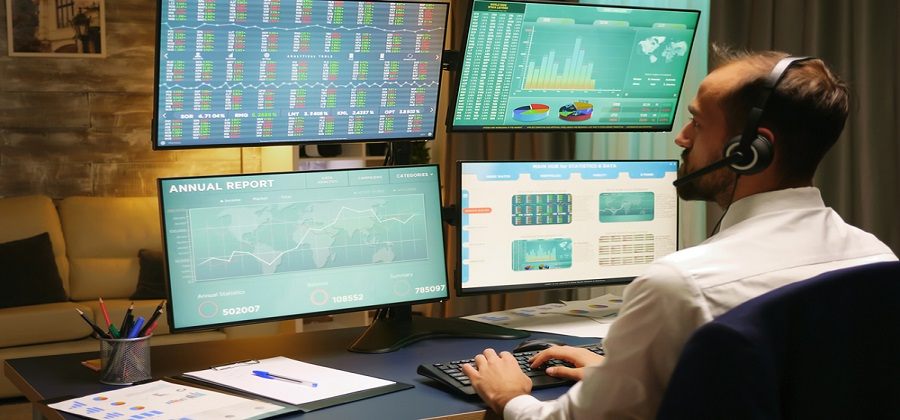If you’re looking to set up a multi-monitor workstation, you may be wondering if your laptop is capable of supporting multiple monitors. The good news is that many modern laptops do have the capability to support multiple monitors, but there are some important factors to consider before you start connecting additional displays.
In this article, we’ll explore the different types of laptop connections for multiple monitors, the limitations of your laptop’s graphics card, and some tips for setting up and using multiple displays on your laptop. So, let’s dive in and find out if your laptop can support four monitors.
Can Laptop Support 4 Monitors?
Yes, laptop can support 4 monitors but only if the laptop has two video out ports and you use a special cable to connect the four monitors. While laptops typically have just a single video output, many of them also have an HDMI port. With the right adapter, you can connect your laptop to multiple monitors and enjoy a much larger work area.
How to Check if Your Laptop Can Support 4 Monitors?
If you’re looking to expand your laptop’s display setup and wondering if it can support four monitors, there are several factors to consider. In this article, we’ll guide you through the process of checking if your laptop can support four monitors.
- Check Your Laptop’s Graphics Card
The graphics card is the most critical component that determines whether or not your laptop can support multiple monitors. Check your laptop’s specifications to see what graphics card it has. If you have an integrated graphics card, it might not support four monitors.
- Check the Number of Video Ports
The number of video ports available on your laptop will determine how many monitors you can connect. If your laptop has multiple video ports, it’s more likely to support four monitors. Common video ports include HDMI, VGA, and DisplayPort.
- Check the Resolutions and Refresh Rates
Another essential factor to consider is the resolution and refresh rate of your laptop’s graphics card and the monitors you want to connect. Ensure that the graphics card can support the desired resolutions and refresh rates for all four monitors.
- Consider Using a Docking Station
If your laptop doesn’t have enough video ports, you can consider using a docking station. A docking station will allow you to connect multiple monitors to your laptop through a single USB-C or Thunderbolt port.
- Check for Compatibility
Before purchasing any additional monitors, make sure they’re compatible with your laptop and its graphics card. Check the specifications of the monitors to ensure that they support the same video ports and resolutions as your laptop.
Options for Connecting 4 Monitors to a Laptop
If your laptop is capable of supporting four monitors, you’ll need to know your options for connecting them. Here are some of the most common ways to connect 4 monitors to a Laptop:
- Docking Station: A docking station is a device that connects to your laptop and provides additional ports, including video outputs. Some docking stations can support up to four monitors.
- HDMI Splitter: An HDMI splitter takes the signal from one HDMI output and splits it into two or more outputs. However, keep in mind that this method will duplicate the same screen on all four monitors.
- USB to VGA/HDMI/DVI Adapter: A USB adapter can be used to add additional video outputs to your laptop. Some adapters can support up to four monitors, but keep in mind that USB adapters may not be able to handle high-resolution displays or fast refresh rates.
- Graphics Card: If your laptop has a Thunderbolt 3 port or an ExpressCard slot, you can use an external graphics card (eGPU) to add additional video outputs. However, this option can be expensive and requires additional setup.
- Wireless Display Adapter: If your laptop and monitors support Miracast or Wi-Fi Direct, you can use a wireless display adapter to connect to the monitors. This option may not be suitable for gaming or other activities that require low latency.
Top Laptops that Support 4 Monitors
For a power user who needs to connect four monitors to your laptop, you’ll need a laptop with a powerful graphics card and multiple display ports. Here are some of the top laptops that can support 4 monitors:
- Dell Precision 7730: This laptop is a beast when it comes to handling multiple displays. It comes with a powerful Nvidia Quadro P5200 graphics card and four display ports.
- HP ZBook Studio x360: This 2-in-1 laptop is designed for creative professionals who need a portable workstation. It features an Nvidia Quadro P1000 graphics card and four Thunderbolt 3 ports.
- Lenovo ThinkPad P53: The ThinkPad P53 is a powerful workstation laptop that can support up to four external displays. It comes with an Nvidia Quadro T2000 graphics card and four display ports.
- ASUS ProArt StudioBook Pro X: This laptop is designed for content creators who need a powerful machine for demanding applications. It features an Nvidia Quadro RTX 5000 graphics card and four Thunderbolt 3 ports.
- Acer Predator Triton 500: The Predator Triton 500 is a gaming laptop that can also handle multiple displays. It comes with an Nvidia GeForce RTX 2080 graphics card and four display ports.
Factors to Consider When Choosing a Laptop for 4 Monitors
There are several factors that you need to consider before buying a laptop for 4 monitors. Here are some of the most important things to keep in mind for 4 monitors setups:
- Graphics card: A powerful graphics card is essential for running 4 monitors smoothly. Look for a laptop with a dedicated graphics card that has enough VRAM to handle multiple displays. Nvidia and AMD are the two major manufacturers of graphics cards for laptops.
- Processor: A laptop with a fast processor will ensure that your system runs smoothly even with 4 monitors connected. Look for a laptop with a quad-core or higher processor for the best performance.
- RAM: To ensure smooth multitasking, you need a laptop with at least 16GB of RAM. This will allow you to run multiple applications simultaneously without slowing down your system.
- Port availability: Look for a laptop with multiple ports that support your monitor’s connectivity. HDMI, DisplayPort, and USB-C are the most common ports used for connecting multiple monitors.
- Screen size: A laptop with a larger screen size is preferable for multiple monitors as it will provide more workspace. Look for a laptop with at least a 15-inch screen size for optimal use.
- Battery life: Running 4 monitors requires a lot of power, so make sure to choose a laptop with good battery life. This will ensure that you can use your laptop for an extended period without needing to connect it to a power source.
- Weight and portability: If you plan to travel with your laptop, consider its weight and portability. A lightweight and compact laptop will be easier to carry around, but it may come with a compromise on the screen size
Are 4 Monitors Supported by A Laptop?
Yes, you can connect four monitors to a laptop computer, whether it’s a PC or Mac. All you need is the right video ports and an adapter or two.
Most laptops have at least one video output port. Common ones include HDMI, DisplayPort, DVI, and VGA. If your laptop only has one video output port, you can still connect multiple monitors by using a USB video adapter or a Thunderbolt™ 3 to Dual DisplayPort Adapter.
Conclusion
In conclusion, the ability to connect four monitors to a laptop depends on the laptop’s graphics card and the number of available video outputs. The best way to check if a laptop can support four monitors is to check the specifications of the laptop’s graphics card and the number of video outputs it has. If a laptop doesn’t support four monitors, there are several options available to increase the number of displays, such as using a docking station or USB adapters.
We’ve listed some of the top laptops that support four monitors, but there are many other options available in the market. It’s essential to do your research and choose a laptop that meets your specific requirements and budget.
Overall, with the right laptop and setup, connecting four monitors to a laptop can greatly enhance productivity and make multitasking more efficient. Just be sure to check your laptop’s specifications and choose a model that can handle the demands of multiple displays.














